Text by
Travis Rayne Pickering
OVERVIEW OF SIGNIFICANCE
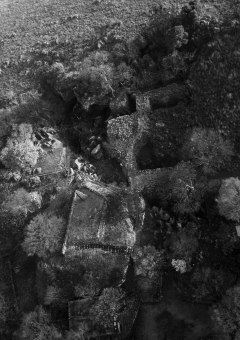 Swartkrans aerial view. Photo by Jason Heaton with the help of Andre Botha (pilot).Swartkrans Cave (Gauteng, South Africa), located ~40 km northwest of Johannesburg, in Gauteng Province, South Africa, is one of the world’s most important paleoanthropological sites. Robert Broom and John Robinson’s early research at Swartkrans (1948 – 1949 and 1951 – 1953) provided large samples of the Plio-Pleistocene hominid Paranthropus (Australopithecus) robustus and demonstrated that it was a contemporary of Homo ergaster, a species that is probably a direct ancestor of modern humans. C.K. (Bob) Brain’s subsequent work at the site (1965 – 1986) resulted in the recovery of large fossil and archaeological samples that, because they were collected with acute regard for stratigraphy and taphonomy, provide essential context for those extinct hominids. Importantly, Brain analyzed these samples within a robust actualistic framework, allowing him to draw novel inferences about early hominid behavior at Swartkrans between c. 1.8 and 1.0 million years ago (mega annum, Ma). Included among Brain’s most important results were: (1) the recognition that many of the hominids were collected in the cave as the prey of large carnivores; (2) the identification of bone tools used by hominids for digging activities; (3) the identification of burned bones from Member 3, indicating some of the earliest known control of fire by hominids at c. 1.0 Ma ago. Brain also recovered archaeological samples that include the second largest collection of Developed Oldowan/Early Acheuelan stone tools in southern Africa and the largest and most behaviorally informative collections of large mammal remains butchered by Earlier Stone Age hominids in the subregion.
Swartkrans aerial view. Photo by Jason Heaton with the help of Andre Botha (pilot).Swartkrans Cave (Gauteng, South Africa), located ~40 km northwest of Johannesburg, in Gauteng Province, South Africa, is one of the world’s most important paleoanthropological sites. Robert Broom and John Robinson’s early research at Swartkrans (1948 – 1949 and 1951 – 1953) provided large samples of the Plio-Pleistocene hominid Paranthropus (Australopithecus) robustus and demonstrated that it was a contemporary of Homo ergaster, a species that is probably a direct ancestor of modern humans. C.K. (Bob) Brain’s subsequent work at the site (1965 – 1986) resulted in the recovery of large fossil and archaeological samples that, because they were collected with acute regard for stratigraphy and taphonomy, provide essential context for those extinct hominids. Importantly, Brain analyzed these samples within a robust actualistic framework, allowing him to draw novel inferences about early hominid behavior at Swartkrans between c. 1.8 and 1.0 million years ago (mega annum, Ma). Included among Brain’s most important results were: (1) the recognition that many of the hominids were collected in the cave as the prey of large carnivores; (2) the identification of bone tools used by hominids for digging activities; (3) the identification of burned bones from Member 3, indicating some of the earliest known control of fire by hominids at c. 1.0 Ma ago. Brain also recovered archaeological samples that include the second largest collection of Developed Oldowan/Early Acheuelan stone tools in southern Africa and the largest and most behaviorally informative collections of large mammal remains butchered by Earlier Stone Age hominids in the subregion.
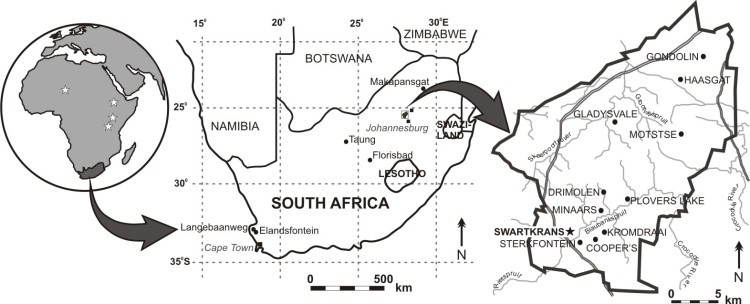 Overview of Cradle of Humankind sites. Map as appears in Sutton et al (2009).
Overview of Cradle of Humankind sites. Map as appears in Sutton et al (2009).
PERSONALITIES AND HISTORY OF DISCOVERY
•RAYMOND DART (1893 – 1988) was an Australian-born neuroanatomist who never worked at Swartkrans Cave, but was a founding father of human evolutionary studies in South Africa and inspired directly the major players who would ultimately bring renown to Swartkrans (see below). Dart’s great early achievement was the 1924 discovery of South Africa’s first ancient hominid fossil—the skull of a 3 or 4 year old individual from the cave site of Taung (hence, the fossil’s nickname, the “Taung Child”). 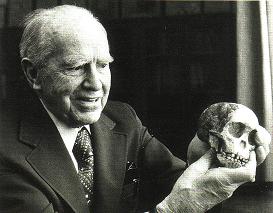 Raymond Dart with Taung Child. Wikimedia Commons.Dart recognized immediately that the specimen was a prehistoric relative of modern humans (the species was eventually dated between 3 – 2 Ma), naming his find Australopithecus africanus, the “southern ape(-man) of Africa.” More specimens of Australopithecus africanus were eventually found at the caves sites of Sterkfontein and Makapansgat. Dart took a keen interest, in particular, in the latter site and its large collection of antelope and baboon bones that intermingled with the Australopithecus africanus fossils recovered there. He concluded from his analyses of those bones that they derived from animals killed and consumed by Australopithecus africanus and that Makapansgat served as a camp to which selected parts of the prey were then transported to be utilized as tools of predation and murder by Australopithecus africanus. Regarding homicide, Dart noted traumatic damage to many Australopithecus africanus skulls, which he interpreted as evidence of interpersonal violence. Dart combined these conclusions into an influential hypothesis of early hominids as “Killer Apes,” who carried out their deadly activities with bone, tooth and horn—or, “osteodontokeratic”—tools. Dart’s ideas permeated popular culture throughout the 1950s and 1960s, even showing up in Stanley Kubrick’s classic film 2001: A Space Odyssey, which opens with scenes of early hominids learning to hunt and murder using bone weapons.
Raymond Dart with Taung Child. Wikimedia Commons.Dart recognized immediately that the specimen was a prehistoric relative of modern humans (the species was eventually dated between 3 – 2 Ma), naming his find Australopithecus africanus, the “southern ape(-man) of Africa.” More specimens of Australopithecus africanus were eventually found at the caves sites of Sterkfontein and Makapansgat. Dart took a keen interest, in particular, in the latter site and its large collection of antelope and baboon bones that intermingled with the Australopithecus africanus fossils recovered there. He concluded from his analyses of those bones that they derived from animals killed and consumed by Australopithecus africanus and that Makapansgat served as a camp to which selected parts of the prey were then transported to be utilized as tools of predation and murder by Australopithecus africanus. Regarding homicide, Dart noted traumatic damage to many Australopithecus africanus skulls, which he interpreted as evidence of interpersonal violence. Dart combined these conclusions into an influential hypothesis of early hominids as “Killer Apes,” who carried out their deadly activities with bone, tooth and horn—or, “osteodontokeratic”—tools. Dart’s ideas permeated popular culture throughout the 1950s and 1960s, even showing up in Stanley Kubrick’s classic film 2001: A Space Odyssey, which opens with scenes of early hominids learning to hunt and murder using bone weapons.
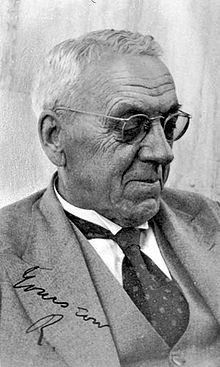 Robert Broom. Wikimedia Commons.•ROBERT BROOM (1866 – 1951) was Scottish-born physician who pursued his early paleontological interests on the origins of mammals fossil prospecting in Australia and the Karoo region of South Africa. Broom was so impressed with Raymond Dart’s discovery of the Taung Child that he switched his focus to the study of human evolution. Broom received a research post at the Transvaal Museum (Pretoria, South Africa) in 1934 and began working limestone quarries in and around the Sterkfontein Valley, searching for an adult of Australopithecus africanus. An adult specimen was finally discovered at Sterkfontein Cave in 1936. Due to a drop in lime prices, mining at Sterkfontein ceased in 1939. The halt in mining also closed down fossil prospecting at the site until 1947 when, Jan Smuts, the Prime Minister of the Union of South Africa, called upon Broom to continue his work there. Broom was joined for a new round of research at Sterkfontein by JOHN ROBINSON (1923 – 2001), which lasted until January 1949.
Robert Broom. Wikimedia Commons.•ROBERT BROOM (1866 – 1951) was Scottish-born physician who pursued his early paleontological interests on the origins of mammals fossil prospecting in Australia and the Karoo region of South Africa. Broom was so impressed with Raymond Dart’s discovery of the Taung Child that he switched his focus to the study of human evolution. Broom received a research post at the Transvaal Museum (Pretoria, South Africa) in 1934 and began working limestone quarries in and around the Sterkfontein Valley, searching for an adult of Australopithecus africanus. An adult specimen was finally discovered at Sterkfontein Cave in 1936. Due to a drop in lime prices, mining at Sterkfontein ceased in 1939. The halt in mining also closed down fossil prospecting at the site until 1947 when, Jan Smuts, the Prime Minister of the Union of South Africa, called upon Broom to continue his work there. Broom was joined for a new round of research at Sterkfontein by JOHN ROBINSON (1923 – 2001), which lasted until January 1949.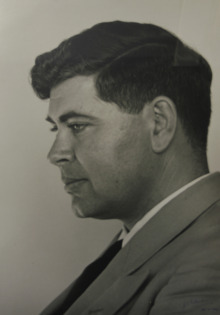 John T. Roinbson. Courtesy of the University of the Witwatersrand.
John T. Roinbson. Courtesy of the University of the Witwatersrand.
At that time Broom and Robinson turned their attentions entirely across the Sterkfontein Valley to the site of Swartkrans Cave, on the north bank of the Blauubank River, less than one kilometer away from Sterkfontein Cave. Broom and Robinson’s work at Swartkrans was almost immediately rewarded. The mandible of a hominid was found in the first week of work there; it was thick and sturdily built with teeth covered in very thick enamel, and Broom realized it was a different species than Australopithecus africanus. He named taxon it represented Paranthropus crassidens to distinguish it from another robustly constructed species, Paranthropus robustus, he found at the nearby site of Kromdraai in 1938. Most paleoanthropologists now consider the two species proposed by Broom to actually be one and apply the name of the first discovered, Paranthropus robustus (or Australopithecus robustus), to specimens from both sites.
Excitingly, by April 1949 a new type of hominid was also discovered at Swartkrans in the form of a mandible that was more lightly built and modern human-like in form. Broom and Robinson assigned it a novel species, Telanthropus capensis. Eventually, this specimen was transferred into Homo, the same genus to which modern humans belong. Its discovery in the same stratigraphic level as Paranthropus robustus fossils was first evidence anywhere in the world that two separate forms of extinct hominid co-existed in the past. That fact was confirmed dramatically just over 20 years later when RONALD J. 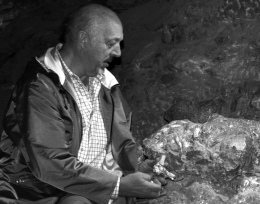 Ron J. Clarke with Stw 573 (Little Foot). CLARKE (1944 – ) recognized, reconstructed and described a beautiful partial cranium of Homo from Swartkrans. The species to which these human-like specimens are now assigned is Homo ergaster, a taxon also known from other sites in Africa, dated between 1.9 – 1.4 Ma.
Ron J. Clarke with Stw 573 (Little Foot). CLARKE (1944 – ) recognized, reconstructed and described a beautiful partial cranium of Homo from Swartkrans. The species to which these human-like specimens are now assigned is Homo ergaster, a taxon also known from other sites in Africa, dated between 1.9 – 1.4 Ma.
Hundreds of individual hominid fossils (mostly of Paranthropus robustus) were recovered by Broom and Robinson until Broom’s death in 1951. Robinson continued the work at Swartkrans until 1953.
•CHARLES KIMBERLIN (BOB) BRAIN (1931 – ) is a (Rhodesian-born) South African naturalist who was so provoked by Raymond Dart’s idea of early hominids as “Killer Apes” that he tested it, first by studying bone-collecting and modifying processes in the modern world so that his understanding of those processes could be used to interpret the formation of ancient bone assemblages from the South African cave sites. This type of approach is called actualism—observing the cause-and-effect relationships of processes and results in the modern world and then applying those results through analogical reasoning to reconstruct the unobservable dynamics of the past. Taphonomists are scientists who use an actualistic approach in the study specifically of the transition of organic remains into fossils. Brain is a pioneering taphonomist in human evolutionary studies, introducing essential theory and methodology beginning in the 1960s and continuing until today.
It was in 1965, when he succeeded John Robinson as Paleontologist at the Transvaal Museum, that Brain was able to apply his modern-world knowledge to the interpretation of South African fossils.
Brain does the best job in summarizing his findings from his excavations at Swartkrans: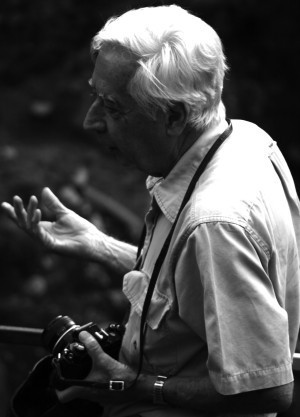 Bob Brain at Swartkrans (early 2006).
Bob Brain at Swartkrans (early 2006).
“When I started to analyze other ancient and modern fossil bone assemblages, it soon became apparent that skeletal disproportions were common and were the inevitable result of the fact that some skeletal parts survive destructive treatment better than others. As an example, in a sample of 2373 modern goat bones discarded by Nama peoples around their Namib Desert villages of Namibia and then chewed by their dogs, I found 87 distal humerus pieces, but not a single proximal end. The reason was clear: while the distal humerus is a solid dense piece of bone with a relatively high specific gravity, this was not true for the upper end, which has a fragile spongy structure with a much lower specific gravity, and is easily destroyed for the marrow it contains. Interestingly enough, the overall survival of goat skeletal parts in the Namib sample closely mirrored the figures that Dart had encountered in his sample of antelope bones from Makapansgat, so there was no longer any reason to invoke deliberate hominid selection to explain the discrepancies…
“But what about the fact that Dart’s fossil antelope skeletons from Makapansgat were so much better represented than were the ape-men and the baboons there? The same story came to light at the Swartkrans Cave where, although we had remains of over 150 individual hominids, based on parts of their skulls, other bones from their skeletons were almost completely absent. This became known as ‘the mystery of the missing bodies.’ Light was thrown on this dilemma when I studied the feeding behavior of group of captive cheetahs on a game-farm in Namibia. When these cheetahs ate a springbuck or a sheep, they did very little damage to the bones of the skeletons, but when they fed on a baboon of comparable live-weight, they would chew up the entire vertebral column and most of the limb-bones, leaving the skull intact. It turned out that a primate skeleton is simply much more chewable and susceptible to damage from a carnivore than is that of an antelope of comparable live-weight.
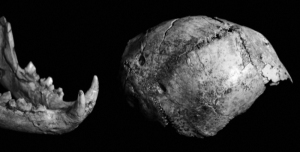 Leopard mandible (left) with SK 54 (right) showing puncture marks.Another insight into this came to light at Swartkrans when we found that the back of the skull of a child had two small round holes in its parietal bones. I noticed that the distance between these holes was matched very closely by that of the lower canines of a fossil leopard from the same part of the cave. My interpretation was that the child had been killed by a leopard, probably by the usual neck-bite, and then picked up with the lower canines in the back of the head and the upper ones in the child’s face. It was then carried into the lower parts of the cave, and consumed there.
Leopard mandible (left) with SK 54 (right) showing puncture marks.Another insight into this came to light at Swartkrans when we found that the back of the skull of a child had two small round holes in its parietal bones. I noticed that the distance between these holes was matched very closely by that of the lower canines of a fossil leopard from the same part of the cave. My interpretation was that the child had been killed by a leopard, probably by the usual neck-bite, and then picked up with the lower canines in the back of the head and the upper ones in the child’s face. It was then carried into the lower parts of the cave, and consumed there.
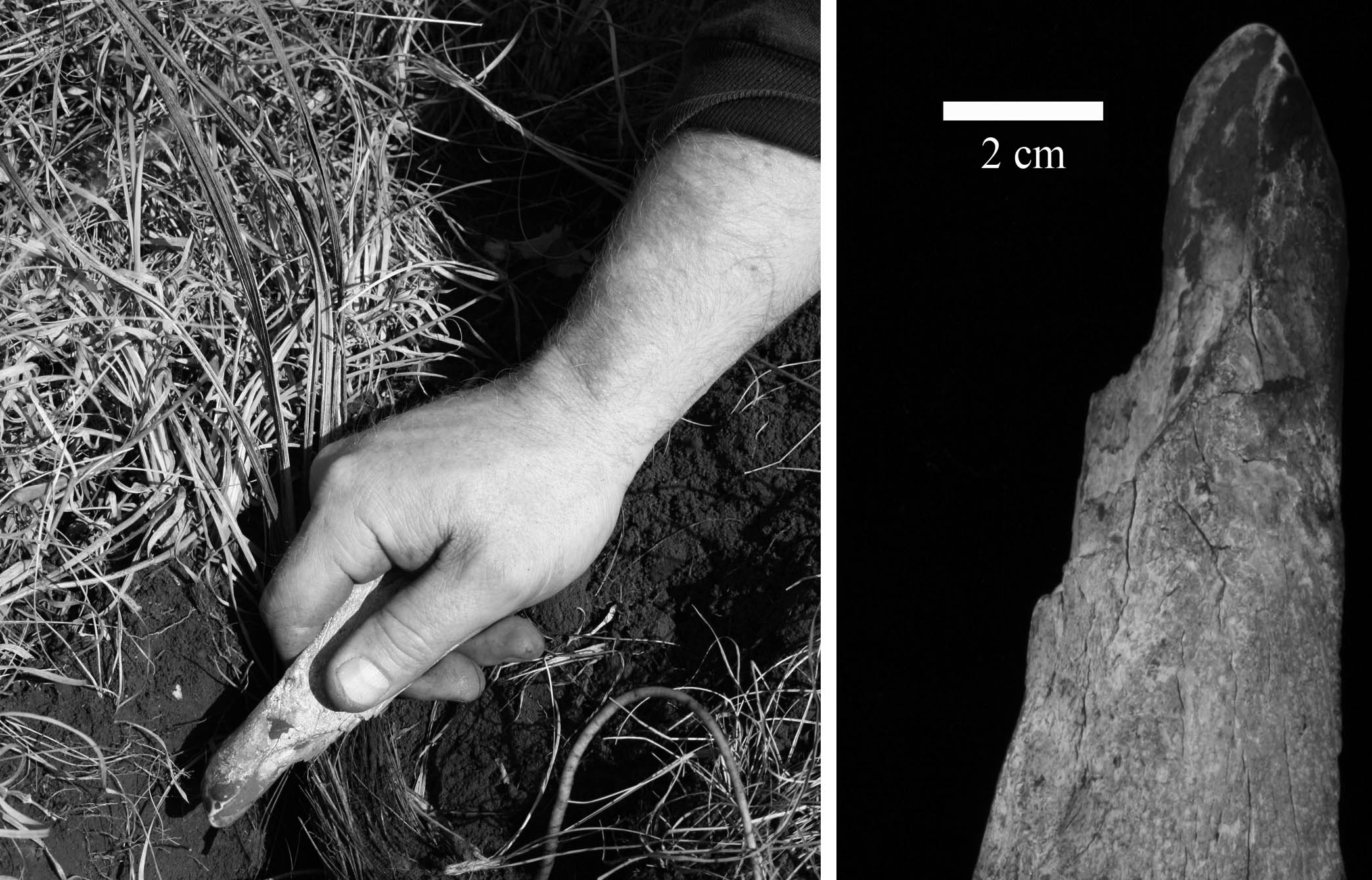 Experimental tuber digging tool.“The Swartkrans Cave story, that gradually developed as my excavation progressed, was that both our early human ancestors [Homo ergaster] and our relatives…[Paranthropus robustus] were living in an open savanna environment there between two and one million years ago and that they regularly sought shelter near the cave’s entrance, probably on cold winter nights. Here they were preyed upon by leopards and sabre-toothed cats, that consumed them in the deeper parts of the cave. [Paranthropus robustus] disappeared from the scene about a million years ago, while our own ancestors experienced a steady enlargement of their brain-size, providing them with improved intelligence and technology, such as the management of fire, the earliest evidence for which has come from this remarkable Swartkrans Cave, as well as evidence for the use of bone tools. These consisted of pieces of long-bones, that showed remarkable wear and scratch-marks that we were able to replicate experimentally when we used fresh bone pieces to dig edible tubers from the Swartkrans hillside…”
Experimental tuber digging tool.“The Swartkrans Cave story, that gradually developed as my excavation progressed, was that both our early human ancestors [Homo ergaster] and our relatives…[Paranthropus robustus] were living in an open savanna environment there between two and one million years ago and that they regularly sought shelter near the cave’s entrance, probably on cold winter nights. Here they were preyed upon by leopards and sabre-toothed cats, that consumed them in the deeper parts of the cave. [Paranthropus robustus] disappeared from the scene about a million years ago, while our own ancestors experienced a steady enlargement of their brain-size, providing them with improved intelligence and technology, such as the management of fire, the earliest evidence for which has come from this remarkable Swartkrans Cave, as well as evidence for the use of bone tools. These consisted of pieces of long-bones, that showed remarkable wear and scratch-marks that we were able to replicate experimentally when we used fresh bone pieces to dig edible tubers from the Swartkrans hillside…”
Brain’s ceased his fieldwork at Swartkrans in 1986, capping it with the 1993 publication of the Transvaal Museum Monograph Swartkrans: A Cave’s Chronicle of Early Man. The volume is an important summary of his results and joins hundreds of Brain’s other publications, including The Hunters or the Hunted? An Introduction to African Cave Taphonomy (1981, University of Chicago Press), the essential volume on taphonomy in paleoanthropology.
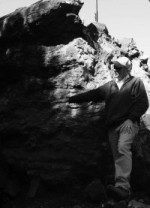 Morris Sutton explaining the Lower Bank deposit to the 2008 Swartkrans fieldschool students.Brain, however, never disengaged with taphonomy, human evolutionary studies and Swartkrans, inspiring a new generation of scientists to take up these pursuits in Africa and elsewhere. Included among this group of enthusiasts are the members of the Swartkrans Paleoanthropological Research Project (SPRP), formed in 2005.
Morris Sutton explaining the Lower Bank deposit to the 2008 Swartkrans fieldschool students.Brain, however, never disengaged with taphonomy, human evolutionary studies and Swartkrans, inspiring a new generation of scientists to take up these pursuits in Africa and elsewhere. Included among this group of enthusiasts are the members of the Swartkrans Paleoanthropological Research Project (SPRP), formed in 2005.
The SPRP is coordinated by Brain and directed by TRAVIS PICKERING. Pickering also serves as the project’s taphonomist, zooarchaeologist and one of its macromammal paleontologists. Joining Brain and Pickering are (in alphabetical order): RONALD CLARKE (paleontologist and primate specialist); JASON L. HEATON (paleontologist and primate specialist); KATHLEEN KUMAN (archaeologist); ANDREW PHASWANA (field technician); MORRIS SUTTON (archaeologist and site supervisor).